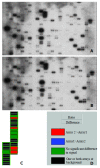Integrin gene expression profiles of human hepatocellular carcinoma
- PMID: 12174369
- PMCID: PMC4656311
- DOI: 10.3748/wjg.v8.i4.631
Integrin gene expression profiles of human hepatocellular carcinoma
Abstract
Aim: To investigate gene expression profiles of integrin genes in hepatocellular carcinoma (HCC) through the usage of Atlas Human Cancer Array membranes, semi-quantitative reverse transcription polymerase chain reaction (RT-PCR) and Northern blot.
Methods: Hybridization of cDNA array membrane was performed with alpha(32)P-labeled cDNA probes synthesized from RNA isolated from hepatocellular carcinoma and adjacent non-cirrhotic liver. AtlasImage, which is a software specific to array, was used to analyze the result. RT-PCR of 24 pairs specimen and Northern blot of 4 pairs specimen were used to confirm the expression pattern of some integrin genes identified by Atlas arrays hybridization.
Results: Among 588 genes spotted in membrane, 17 genes were related to integrin. Four genes were up-regulated, such as integrin alpha8, beta1, beta7 and beta8 in HCC. Whereas there were no genes down-regulated in HCC. RT-PCR and Northern blot analysis of integrin beta1 gene gave results consistent with cDNA array findings.
Conclusion: Investigation of these integrin genes should help to disclose the molecular mechanism of the cell adhesion, invasive and metastasis of HCC. A few genes are reported to have changed in HCC for the first time. The quick and high-throughout method of profiling gene expression by cDNA array provides us overview of key factors that may involved in HCC, and may find the clue of the study of HCC metastasis and molecular targets of anti-metastasis therapy. The precise relationship between the altered genes and HCC is a matter of further investigation.
Figures



Similar articles
-
Gene expression profiles of hepatoma cell line HLE.World J Gastroenterol. 2003 Apr;9(4):683-7. doi: 10.3748/wjg.v9.i4.683. World J Gastroenterol. 2003. PMID: 12679910 Free PMC article.
-
Expression of cell cycle/growth regulator genes in human hepatocellular carcinoma and adjacent normal liver tissues.Oncol Rep. 2003 Nov-Dec;10(6):1771-5. Oncol Rep. 2003. PMID: 14534694
-
Gene expression profiles of hepatoma cell line BEL-7402.Hepatogastroenterology. 2003 Sep-Oct;50(53):1496-501. Hepatogastroenterology. 2003. PMID: 14571772
-
Expression of cytochrome P4502E1 gene in hepatocellular carcinoma.World J Gastroenterol. 2004 Jun 1;10(11):1565-8. doi: 10.3748/wjg.v10.i11.1565. World J Gastroenterol. 2004. PMID: 15162526 Free PMC article.
-
Molecular profiling of hepatocellular carcinomas by cDNA microarray.World J Gastroenterol. 2005 Jan 28;11(4):463-8. doi: 10.3748/wjg.v11.i4.463. World J Gastroenterol. 2005. PMID: 15641127 Free PMC article. Review.
Cited by
-
PDGF enhances IRES-mediated translation of Laminin B1 by cytoplasmic accumulation of La during epithelial to mesenchymal transition.Nucleic Acids Res. 2012 Oct;40(19):9738-49. doi: 10.1093/nar/gks760. Epub 2012 Aug 16. Nucleic Acids Res. 2012. PMID: 22904067 Free PMC article.
-
Genome-wide screening identified that miR-134 acts as a metastasis suppressor by targeting integrin β1 in hepatocellular carcinoma.PLoS One. 2014 Feb 3;9(2):e87665. doi: 10.1371/journal.pone.0087665. eCollection 2014. PLoS One. 2014. PMID: 24498348 Free PMC article.
-
The role of CD29-ILK-Akt signaling-mediated epithelial-mesenchymal transition of liver epithelial cells and chemoresistance and radioresistance in hepatocellular carcinoma cells.Med Oncol. 2015 May;32(5):141. doi: 10.1007/s12032-015-0595-x. Epub 2015 Mar 25. Med Oncol. 2015. PMID: 25805567
-
The tumour-promoting receptor tyrosine kinase, EphB4, regulates expression of integrin-β8 in prostate cancer cells.BMC Cancer. 2015 Mar 22;15:164. doi: 10.1186/s12885-015-1164-6. BMC Cancer. 2015. PMID: 25886373 Free PMC article.
-
Inhibitory effects of antisense RNA of HAb18G/CD147 on invasion of hepatocellular carcinoma cells in vitro.World J Gastroenterol. 2003 Oct;9(10):2174-7. doi: 10.3748/wjg.v9.i10.2174. World J Gastroenterol. 2003. PMID: 14562372 Free PMC article.
References
-
- Schafer DF, Sorrell MF. Hepatocellular carcinoma. Lancet. 1999;353:1253–1257. - PubMed
-
- Hanley AJ, Choi BC, Holowaty EJ. Cancer mortality among Chinese migrants: a review. Int J Epidemiol. 1995;24:255–265. - PubMed
-
- Naka T, Toyota N, Kaneko T, Kaibara N. Protein expression of p53, p21WAF1, and Rb as prognostic indicators in patients with surgically treated hepatocellular carcinoma. Anticancer Res. 1998;18:555–564. - PubMed
Publication types
MeSH terms
Substances
LinkOut - more resources
Full Text Sources
Other Literature Sources
Medical

